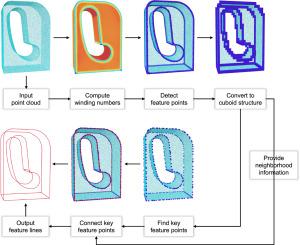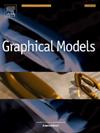Feature line extraction based on winding number
IF 2.2
4区 计算机科学
Q2 COMPUTER SCIENCE, SOFTWARE ENGINEERING
引用次数: 0
Abstract
Sharp feature lines provide critical structural information in 3D models and are essential for geometric processing. However, the performance of existing algorithms for extracting feature lines from point clouds remains sensitive to the quality of the input data. This paper introduces an algorithm specifically designed to extract feature lines from 3D point clouds. The algorithm calculates the winding number for each point and uses variations in this number within edge regions to identify feature points. These feature points are then mapped onto a cuboid structure to obtain key feature points and capture neighboring relationships. Finally, feature lines are fitted based on the connectivity of key feature points. Extensive experiments demonstrate that this algorithm not only accurately detects feature points on potential sharp edges, but also outperforms existing methods in extracting subtle feature lines and handling complex point clouds.

基于圈数的特征线提取
尖锐的特征线在三维模型中提供关键的结构信息,对几何处理至关重要。然而,现有的从点云中提取特征线的算法的性能对输入数据的质量仍然很敏感。本文介绍了一种从三维点云中提取特征线的算法。该算法计算每个点的圈数,并利用边缘区域内圈数的变化来识别特征点。然后将这些特征点映射到一个长方体结构上,以获得关键特征点并捕获相邻关系。最后,根据关键特征点的连通性拟合特征线。大量实验表明,该算法不仅能够准确地检测出潜在尖锐边缘上的特征点,而且在提取细微特征线和处理复杂点云方面都优于现有方法。
本文章由计算机程序翻译,如有差异,请以英文原文为准。
求助全文
约1分钟内获得全文
求助全文
来源期刊

Graphical Models
工程技术-计算机:软件工程
CiteScore
3.60
自引率
5.90%
发文量
15
审稿时长
47 days
期刊介绍:
Graphical Models is recognized internationally as a highly rated, top tier journal and is focused on the creation, geometric processing, animation, and visualization of graphical models and on their applications in engineering, science, culture, and entertainment. GMOD provides its readers with thoroughly reviewed and carefully selected papers that disseminate exciting innovations, that teach rigorous theoretical foundations, that propose robust and efficient solutions, or that describe ambitious systems or applications in a variety of topics.
We invite papers in five categories: research (contributions of novel theoretical or practical approaches or solutions), survey (opinionated views of the state-of-the-art and challenges in a specific topic), system (the architecture and implementation details of an innovative architecture for a complete system that supports model/animation design, acquisition, analysis, visualization?), application (description of a novel application of know techniques and evaluation of its impact), or lecture (an elegant and inspiring perspective on previously published results that clarifies them and teaches them in a new way).
GMOD offers its authors an accelerated review, feedback from experts in the field, immediate online publication of accepted papers, no restriction on color and length (when justified by the content) in the online version, and a broad promotion of published papers. A prestigious group of editors selected from among the premier international researchers in their fields oversees the review process.
 求助内容:
求助内容: 应助结果提醒方式:
应助结果提醒方式:


